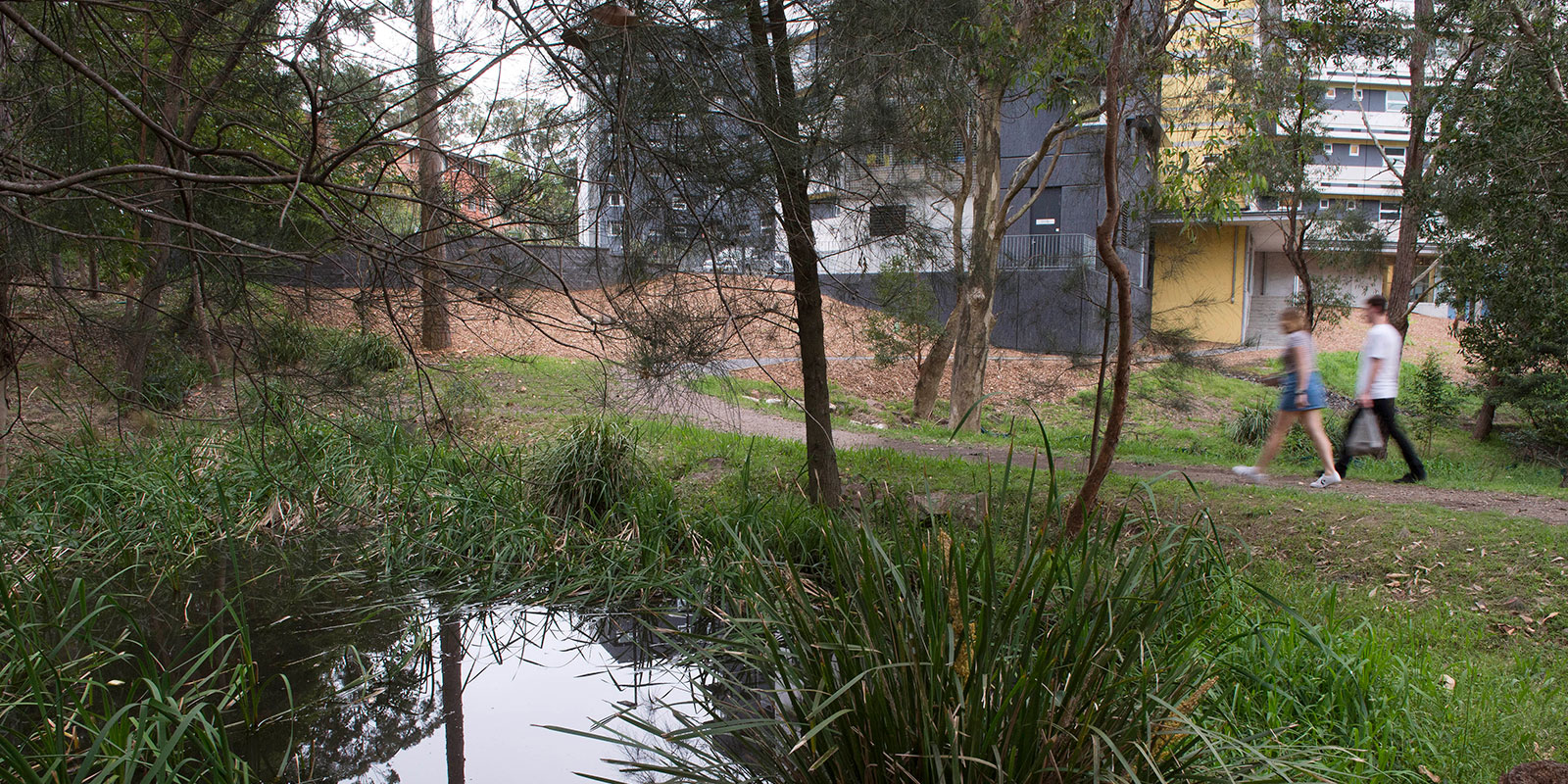

Goal 15:
Life on Land
Local Biodiversity Included in Planning and Development
The University of Newcastle integrates local biodiversity considerations into campus planning and development processes, guided by our Environmental Sustainability Plan and associated policies.
- In the Environmental Sustainability Plan (ESP 2019‑2025) (p. 17), the University commits to actively managing our campus to restore, improve and maintain our unique biodiversity, which serves as a guiding principle for all new developments.
- As part of campus master planning and infrastructure projects, new building proposals are assessed for their impact on native vegetation, wildlife corridors, habitat connectivity, remnant bushland and wetlands.
- The University’s Landscaping and Biodiversity goals require native species planting, habitat regeneration, and ecological offsets or mitigation where development impinges on sensitive areas.
- The Callaghan Landscape Management Implementation Plan further reinforces that when new works or upgrades are planned within or adjacent to bushland or wetland zones, they must comply with the biodiversity and habitat protection requirements set out in the plan (e.g. buffer zones, minimal disturbance, fauna crossing design).
Our Commitment to Environmental Sustainability and Native Biodiversity
At the University of Newcastle, sustainability is a core value that underpins everything we do. Through our Environmental Sustainability Plan, we are committed to creating a more sustainable future for our students, staff, communities and the world.
What Matters Most to Us
We are guided by a shared commitment to:
- Environmental leadership: We aim to be recognised as a leader in environmental sustainability within the higher education sector.
- Equity and inclusion: We understand that sustainability is not only environmental, but also social and economic. We are committed to promoting equity, diversity and inclusion across all aspects of our operations.
- Responsibility to future generations: We take seriously our responsibility to preserve and enhance the environment for future generations.
- Engaged partnerships: We work collaboratively with students, staff, industry, government and community to embed sustainable practices.
- Global and local alignment: We align our actions with international sustainability initiatives while responding to the specific needs of our local communities.
- Integrated sustainability: We embed sustainability principles into our teaching, research, campus operations and decision-making processes.
- Transparency and accountability: We monitor and publicly report our progress toward our sustainability goals.
Our Commitments Under the Policy
Through our Environmental Sustainability Policy and Plan, we commit to:
- Embedding sustainability into all University operations, including strategic planning, procurement, infrastructure, and governance.
- Setting measurable targets and indicators to guide continuous improvement in environmental performance.
- Monitoring, reviewing and publicly reporting on our progress toward key environmental and sustainability goals.
- Proactively managing environmental impacts such as energy consumption, carbon emissions, waste, water use, and biodiversity.
- Engaging our students, staff and wider community in shaping and advancing sustainability initiatives across the university.
- Promoting innovation and research that supports environmental, social and economic sustainability.
- Ensuring compliance with relevant legislation and adopting best practice environmental standards.
- Reviewing and updating our sustainability commitments regularly to remain responsive to emerging challenges and opportunities.
STEMM Building (Callaghan Campus) & Design & Build Sustainability Policies
- The University is developing a STEMM building on the Callaghan campus (site ~1.6 ha) that must comply with State Significant Development (SSD) requirements (including biodiversity and environmental impact assessments).
- Under the University’s Design and Build sustainability goals, all major capital projects (including the STEMM building, Bioresources, and new phases of the Honeysuckle campus) are required to embed Environmentally Sustainable Design (ESD) principles throughout the life cycle — including design, construction, and operation phases.
- These ESD requirements help ensure that new developments do not merely avoid negative impacts on local biodiversity but strive to reduce ecological harm (through design choices, materials, energy use, landscaping, stormwater management).
City Campus Student Accommodation (Honeysuckle Precinct)
- In September 2024, the University lodged a State Significant Development Application (SSDA) for a new student accommodation building in the city campus (Honeysuckle area).
- The project includes landscaping, public domain works, and environmental assessments as part of the approval process, meaning that ecological impacts (on flora, fauna, local habitat) must be considered in the design and site plan.
- The design includes integration of greener and naturally ventilated corridors, and utilization of sustainable building strategies (e.g. planting, water sensitive design) to soften and mitigate environmental impacts.
These examples show that the University intentionally and directly incorporates biodiversity and ecosystem considerations into our planning and development processes, particularly for new major buildings — consistent with policy commitments under the Environmental Sustainability Plan and related frameworks.
The University of Newcastle acknowledges the traditional custodians of the lands within our footprint areas: Awabakal, Darkinjung, Biripai, Worimi, Wonnarua, and Eora Nations. We also pay respect to the wisdom of our Elders past and present.